
31 minute read
UNAPOLOGETICALLY ITALIAN

UNAPOLOGETICALLY ITALIAN
Advertisement


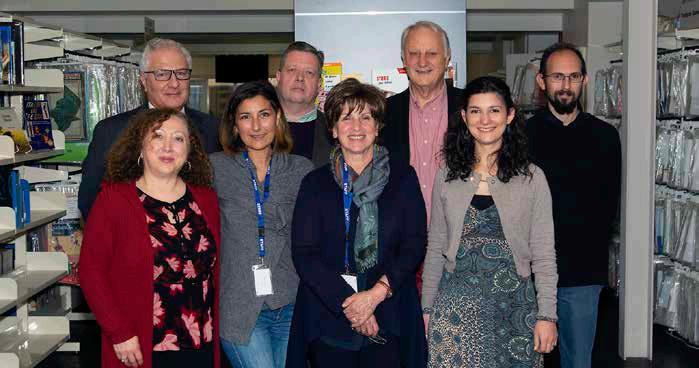
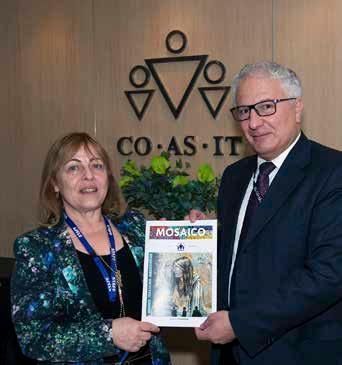
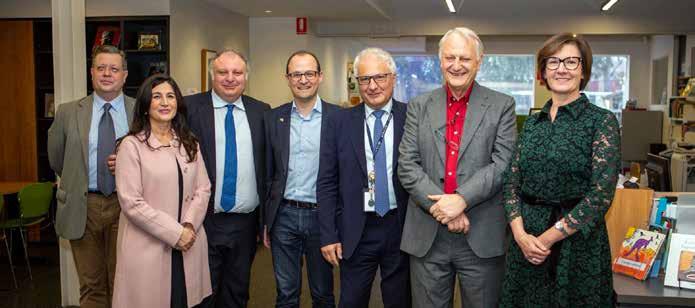















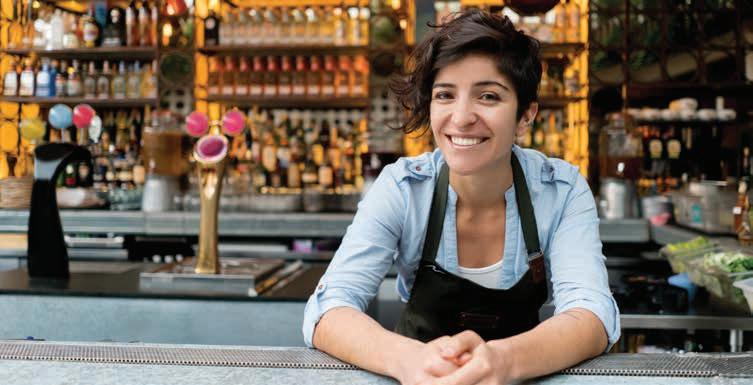
HOW TEACHING ITALIAN HELPS MY STUDENTS TO DISCOVER THEMSELVES IN THE WORLD

Francesco Ricatti

Group of migrants on the deck of MV Castel Verde, Italy, 1950–1957
The teaching of modern European languages and cultures, including Italian Studies, was established within a frame that mirrored the identification of the Nation with its standard language and its canonical literature - which was almost exclusively written by white, middle- or upper-class men.
This model worked on the assumption that such a structure would eventually result in a proud and stable national identity. Yet Italian identities and cultures have always been much more complex, unstable, and contradictory than such a simplified, nationalistic, classist and patriarchal model would like to admit. It is, in other words, a reactionary model that neither accounts for the actual historical, linguistic and cultural complexity of Italy, nor recognises the profound connections between Italy and the world.
To this, we need to add the rapidly changing reality of tertiary education. Once upon a time, an elite of white students could embrace such model as a reassuring path into an exotic experience of a foreign and racially ambiguous country like Italy. Today, students of Italian at university level call for a different approach, one that is much more sensitive to social, cultural and linguistic complexity.
This provides an extraordinary opportunity to rediscover key aspects of Italy, and of the Italian presence in the world, that have been overlooked, if not despised, by most academics. And it explains why a growing number of scholars and students around the world are now fostering a transnational and transcultural turn in Italian studies, and in modern language studies more broadly.
I work for Monash University, which was developed throughout the 1960s and 1970s in the southern outskirts of Melbourne, to cater for the children of working-class parents, including the growing number of children from postwar migrants. Thanks to the economic miracle, the democratic development and the social reforms of the postwar period, these young people were the first in their family to be able to go to university. Nowadays, Monash is one of the most prestigious universities in the world, but still maintains a progressive and multicultural ethos. The majority of my students are women. They come from many different backgrounds, speak many different languages, and study disciplines as different as Arts, Law, Commerce, and Science. The majority of them also need to learn how to reflect on their own complex identities, and how to understand and engage with different cultures. They will need those skills in their life and in their profession. So it is not a surprise that only a few of them show an interest in the classic masterpieces of Italian literature. Rather, most of them are passionate about discovering what complex, multiethnic, multicultural and
multilinguistic country Italy actually is, and in fact has always been.
When catering for these students, we then need to acknowledge the importance of transculturality; that is, we need to provide students with the awareness that every culture is the result of the influences different cultures have on each other when they come into contact. Every culture is in a constant state of flux, and cannot be regimented into a rhetorical, nostalgic and reactionary frame.
Teaching Italian Studies today therefore means to challenge the hegemonic relationship between the Nation, its standard language, and its canonical literature. Literature is still an important component of a humanistic education, but it must be studied in all its complexity, including for instance the work of incredibly talented and powerful writers of Italian literature like Jhumpa Lahiri or Igiaba Scego.
The study of literature can no longer be at the expense of all other forms of creativity and communication, including the many complex expressions of contemporary popular culture. We also need to acknowledge that Italian languages and cultures also exist outside Italy, for instance in my own backyard here in Melbourne. Italian cultures in Australia, Brazil, Somalia or the United States are a crucial part of Italy’s history. Our students need to embrace the social, cultural and linguistic complexity of Italian communities around the world.
Finally, but as importantly, students need to develop intercultural literacy. They need to learn how to learn about other cultures beyond the stereotypes (those about the awful Mafia as well as those about the wonderful Renaissance). And they need to be able to look beyond the established narratives, discovering instead complex stories and histories at the intersection of class, gender, ethnicity, racial appearance, sexual orientation, and body abilities.
Teaching Italian for me is about helping my students to find, in the actual complexity of Italian languages, cultures and societies, those precious intellectual and emotional tools that will help them navigate an increasingly complex and challenging world. After all, in Italian, nascere (to be born) is venire al mondo (to come to the world). To study a second language is a way for students to venire al mondo; that is, not just to discover the world, but to discover themselves in the world. For a few weeks or months, and sometimes for a few years, I have the honour and privilege to guide my students not just throughout Italy, its language, and its culture, but throughout a complex and exciting journey of intellectual
EVER HAD A BURNING CURIOSITY ABOUT ITALY?
Pierluigi Trombetta, Italian Consul in Melbourne with his son Edoardo

We asked a group of Italian kids living in Australia if there was anything they wanted to know, and our
Consulate General of Italy in Melbourne, Pierluigi Trombetta, was only too happy to answer their questions.
1. Why are there so many dialects in Italy? (Sankara, aged 8)
2. Why is Rome the capital of Italy? (Sankara, aged 8)
Italy is not a painting where everything is uniform, but rather a beautiful mosaic where many different pieces come together and create a masterpiece.
Each area of Italy has a different culture, because Italy was separated for hundreds of years and each region of the country has had a different history.
Northern Italy has had closer ties with Central and Northern Europe, Southern Italy has closer links to the Mediterranean.
This led to the development of different cultures, and different cuisines. The dialects also developed separately because many areas of Italy might not even have been able to communicate with each other. All Italian dialects, however, derive from Latin like many other European languages, including Italian, French, Spanish, Portuguese and Romanian.
When Italy became unified in 1861, one of the big problems was that there was no Italian language because there were so many different dialects.
Communicating was almost impossible. A Neapolitan and a Milanese couldn’t understand each other. Then the government decided that the Tuscan dialect, the language used by Dante Alighieri to write the Divine Comedy, would become the Italian language. In reality, however, the Italians continued to speak their own dialects. They only really started speaking in Italian during the First World War, when boys from all over Italy had to fight together and, to communicate, they learned Italian.
Italy was unified in 1861 under the pressure of the Kingdom of Sardinia which included Piedmont and Sardinia. The capital was Turin where even French was spoken. Rome had been the great capital of the Roman Empire and therefore was the natural capital of United Italy. Rome was also in the center of Italy while Turin was far to the north. In those years, however, Rome was the capital of the Church State and was protected by France and was not part of Italy. The first step was therefore to transfer the capital from Turin to Florence and then, when Rome became Italian, to Rome.
3. What is the style of Italian cars and how does it differ from other cars? (Gia, aged 5)
Italian cars are usually more sporty and more elegant. For a long time (during the 50s and 60s), Italian cars were the most sold in Europe, but then there was a period of decline. Now the Fiat Group, which includes Lancia, Alfa Romeo, Abarth, Ferrari, Maserati and Fiat, is again going strong and a few years ago, bought the American Chrysler (Chrysler, Jeep and Dodge). Now the Fiat group is among the top companies in the world.
Italian cars usually have a better design because the best designers are Italian.
4. How many islands does Italy have? (Coco, aged 8)
5. What is the best place to vacation in Italy? (Coco, ages 8)
It depends on what you like to do. If you love the sea there are beautiful places in Sardinia, Sicily, Liguria and Puglia.
I like skiing and the Italian Alps are the best place in the world for skiing. There are slopes where the snow is present all year round and you can ski even in summer like on the Presena glacier.
If you like art then certainly your first trip to Italy must include Rome, Venice, Florence, Naples and Milan but, after the first time, then it is nice to discover the smaller cities that are each more beautiful than the next. Italy is also rich in national parks such as the Stelvio National Park or the Abruzzo National Park.
Another nice way to visit Italy is, if you have Italian origins, to go and see where your ancestors come from.
6. Why is Italian gelato so good? (Ravi aged 6)
In general, the secret of Italian cuisine is that the ingredients are always fresh. gelato is different from icecream. It has less fat, is healthier and better because it is made with top quality ingredients. Gelato is an Italian invention, but some say it is Arabic. It could be possible. Many centuries ago the Arabs controlled Sicily and the Arab culture and cuisine influenced Sicily. It is said that some Arabs in Sicily invented ice cream. Whether it was the Arabs or the Sicilians, the certain thing is that ice cream was invented in Sicily. Or maybe not. The Venetians say that ice cream was actually invented in Veneto. Sicily or Veneto? Sicilians or Sicilian Arabs? Who knows? However it is true that Italian gelato is the best in the world.
ENSURING THE PERPETUATION OF ITALIAN STUDIES PROGRAM INTO THE FUTURE
A stones throw from the centre of Melbourne lies a suburb called Carlton. It is home to the Museo Italiano, CO.AS.IT, the Dante Alighieri Society and the Italian Historical Society.
The bars and cafes on popular Lygon Street are diverse, some are historical establishments, with touters thrusting menus into the hands of passers by, the love projects of post-war migrants. Amongst them are little venues that transport patrons into the heart of modern Rome or Milan, where you’ll be served by someone young, trendy, and newly arrived, and can take your espresso standing at the bar. The influence of Italy on this tiny little corner of the world is undeniable, it is perhaps the suburb that has most reflected the changing face of the Italian migration experience in Australia. It is, however, not the only place in Australia, or indeed, the world, where the Italian cultural presence is felt. Italy was named number 1, in the 2019 Best Countries rankings, formed by the U.S. News and World Report, in partnership with BAV Group, and the University of Pennsylvania.
Italian culture has had a phenomenal influence and is particularly celebrated for its classical art, designer clothing, and of course, its culinary traditions.
Just a short walk from Lygon Street lies the University of Melbourne, home to one of the oldest Italian Studies programs in Australia, where the teaching of the Italian language dates back to the 1920s, and the formal Italian Studies program will have been established 60 years ago this year.
Above and in the next page the launch of the Italian Studies Trust Fund at the University of Melbourne
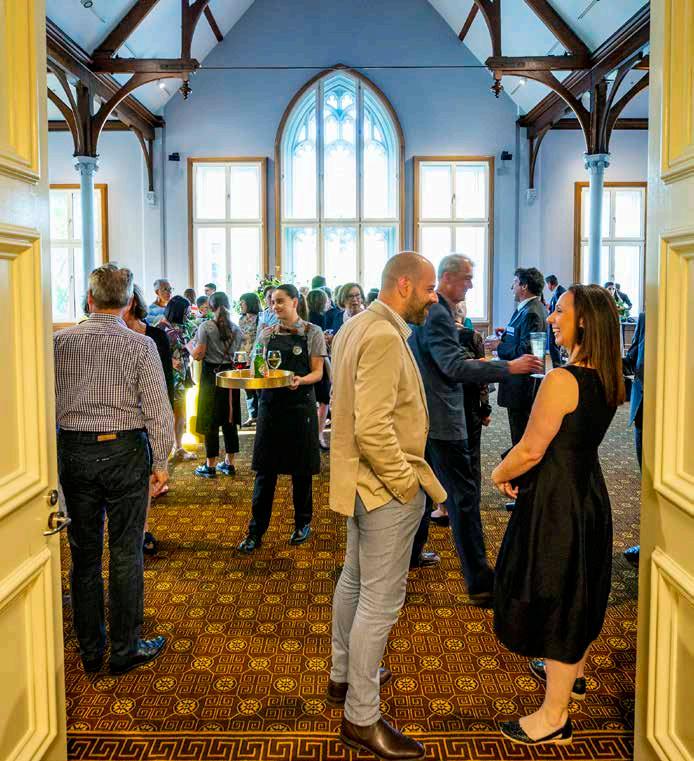
Photo David Hannah
To mark this milestone, and to continue to value the contribution that the Italian language and culture has made in Australia and throughout the world, the University of Melbourne has established a trust fund, which, Professor John Hajek explains, is intended to ensure the continuation of the Italian Studies program well into the future.
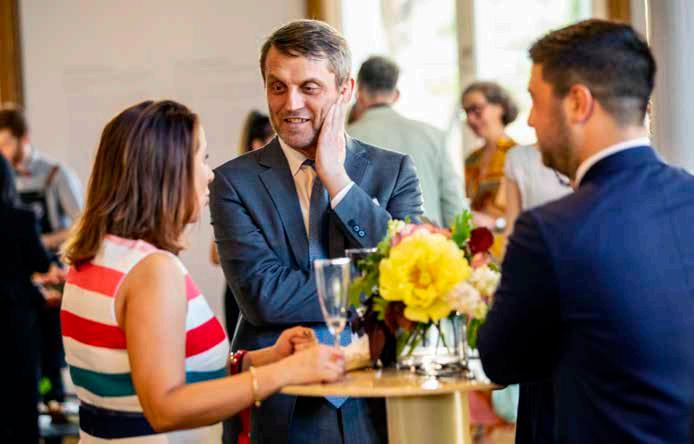
The Italian Studies program at the University of Melbourne runs language classes at beginner, intermediate and advanced levels, as part of diplomas, bachelor degrees and post-graduate courses. The program includes a wide range of studies surrounding culture, including theatre, literature and cinema. Hajek is proud of the Italian Studies program, and much like the changing face of nearby Lygon St, he has seen the student demographic evolve during his years as a member of staff at the University.
Reflection on the state of our homegrown civilisation
Around a month ago, in the main space of the Italian
Cultural Institute, I was sitting in the audience amongst
friends, university lecturers, guests and invitees, including
the newly appointed Ambassador, and there in front of
me was a 17 year old boy with no Italian background,
performing a main role in a farce by Dario Fo.
Listening to his fluent Italian, and noticing his confidence and well-rehearsed comic timing, I realised that Italian language and culture in Australia is cherished, and its dissemination is quite successful. The state of Italian culture in Australia is healthy.
This experience however, provoked in me a series of questions: what is a young Australian audience today? And more importantly, what is Italian Culture?
One of the key differences between my experience at the Italian Cultural Institute in Paris and my tenure here in Melbourne, is of course the strong Italian community that thrives in this city and the history of Italian diaspora. While the role of the Paris Institute is clearly to promote Italian language and culture amongst the French population, strengthening institutional ties and fostering a cross-cultural dialogue, here in Melbourne, a strong part of the population is of Italian background, and this creates a crucial difference.
It has been very important for me in these last years to navigate this complexity on at least two different levels. Firstly, the program I devised was carefully aimed at showcasing the best of contemporary art and culture, with the clear awareness that presenting contemporary excellence also implies dealing with inherited discourses about ‘Italianness’ and the nostalgic view of this that does not always reflect the experiences of Italians today. I have been aware of the way this program intersects with other cultural institutions and cultural expressions here in Melbourne.
Secondly, my aim was to cater for new audiences, like the young actor in the play: curious, proactive, and willing to explore novelty and complexity. This means framing the Institute as a cultural organisation that can dialogue with a wider group of cultural institutions, from the great ‘Italian’ network to contemporary galleries, museums, and universities.
Italian language and culture teaching and learning is also very healthy. We have successful university programs and the teaching of Italian culture across faculties (for example, The University of Melbourne had an exhibition on Terragni in 2018 and teaches the philosophy of Agamben across its Culture and Communication program), alongside well-established private and public courses, we are at a stage in which the need for self-representation and self-recognition goes hand in hand with a more open, diffused and allencompassing presence in the city.
Culture can be thought of as the customs, traditions, mores and ways in which a particular group lives and organises itself. However, culture is also ‘high culture’: the exemplar, the best possible expression of those mores through art and literature, scientific achievements, political legacies etc.
Laura Napolitano
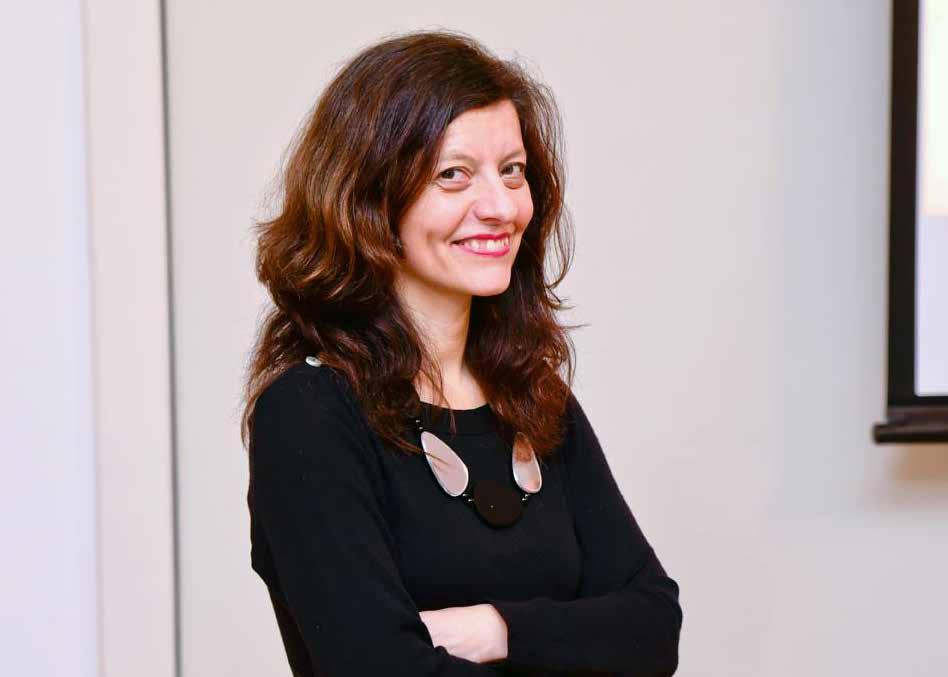
Cultures, however, are intrinsically stratified, fluid, transnational and translingual; in constant dialogue with the world, to the point of making any definition of a border or a unified identity impossible. The risk therefore is that we fall back on a canon or a series of stereotypes. As Director of the Institute, I have tried to respect and celebrate this canon (inviting personalities such as the esteemed Italian conductor and harpsichord virtuoso Rinaldo Alessandrini, the art historian Costantino D’Orazio celebrating Leonardo Da Vinci, the Baroque ensemble I Bassifondi and so on), while exploring the intersections with other perspectives. Some examples will help me clarify this and introduce my conclusions.
In 2018 Liquid Architecture, a Melbourne ‘institution’ in the field of experimental music, approached me and asked me to support a conference on Fascism and aesthetics, organised with the Faculty of Law of the University of Melbourne. We invited the Italian, USbased (again a testament to transnationality), composer Luciano Chessa, an internationally renowned scholar of the Futurist musician Luigi Russolo. We held a series of seminars and a concert that brought to the Istituto a new audience of young artists, students and enthusiasts. Also in 2018, the Istituto organised ‘Counterpoints’, an exhibition of the great 20th century Italian artist Vettor Pisani and Melbourne artist Marco Fusinato.
This was Italian excellence conversing with an artist of Italian background, who has, however, little to do with traditional identity-art. But it was also a conversation between people and institutions: Eugenio Viola, the Italian chief-curator at Perth Institute of Contemporary Arts (PICA) in Perth, the Italian ‘Fondazione Morra’ that enabled the travel of Pisani’s works, and the highly regarded ‘Anna Schwartz Gallery’ that represents Fusinato. Once again, it was the first time Anna Schwartz entered the door of the Institute; symbolically linking our institution to the most important contemporary art milieu of the country. It was a pleasure to read just a week ago that Fusinato has been chosen to represent Australia at the next Venice Biennale: this link has now come to fruition.
Far from being self-celebratory, each project can and should be improved. These two examples however, illustrate my concluding point. Italian language and culture has established ways to be promoted, taught and learned, and the work done in this space has been, and continues to be, amazing. As the fourth generation of the historical diaspora grows to adulthood, and as a new, transnational, global and connected cohort of Australians becomes a cultural consumer, intersecting our way to think Italianness with other dynamic and multimodal experiences is a valuable strategy to keep and foster our important presence into the future.

More than just a holiday! www.vitaitaliantours.com
Chris Gallace and Stephanie Chiarolli at the ruins of Nonno Carmine in Pietracupa, Catanzaro (Calabria)
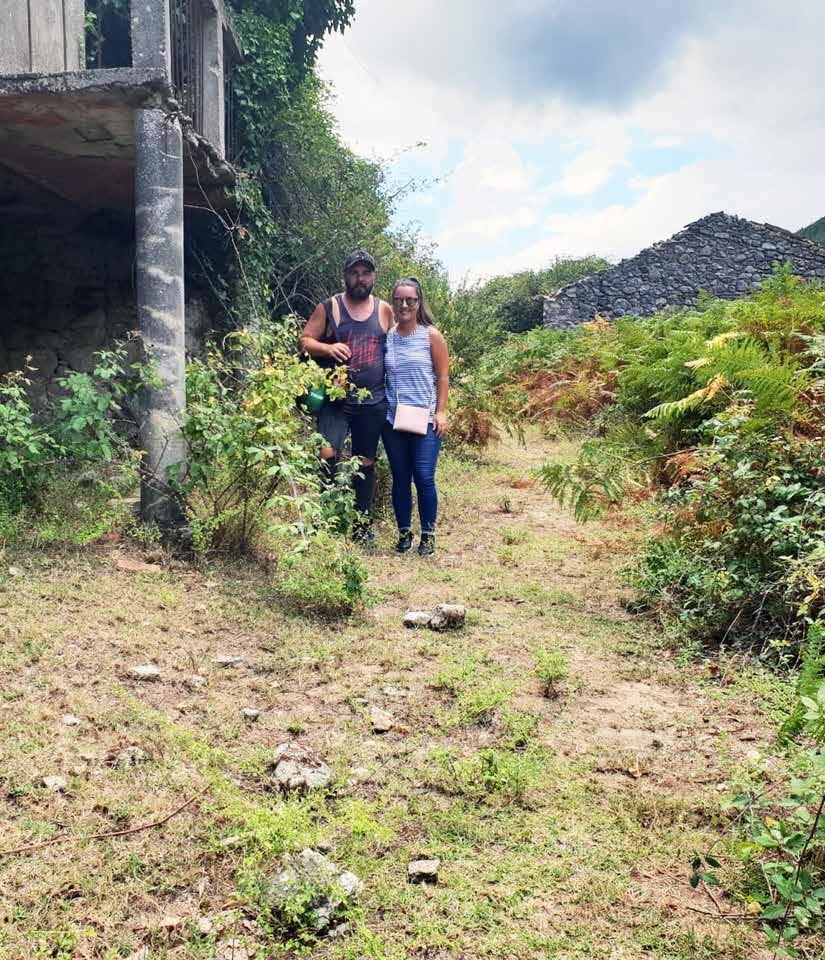
When I think about the future of Italian culture in young(er) generations of Australians, I think of the role of local Italians in global concerns, a phenomonen I call ‘glocalism’!
As an old(er) second generation Italian, I have often been an outlier for seeking glocalism. I’ve written about this in my books Tapestry, an exploration of 5 generations of my family, and Someone You Know, which discusses my family’s resistance to AIDS-phobia and homophobia. I now work with Muslim, Indigenous and other communities as an ally.
I am so heartened to see how younger Italian glocals insist emphatically on their diverse genders and sexualities being affirmed. They draw from their families’ histories of war, poverty, religion, and migration to speak out against racism, Islamophobia, homo/bi/transphobia and to call for the rights of refugees and newly arrived migrants. I am heartened to see that they know that maintaining Italian cultural traditions might be used to hide, ignore and perpetuate the injustices, hierarchies and prejudices that exist within those traditions.
I see glocal Italian-Australians yearning to understand and connect with their Italy of origin, sometimes by ‘finding home’ in the ruins and remnants of war-torn and earth-quaked villages; and exploring and embracing a new ‘home’ in a contemporary Italy that is finally stepping up, acknowledging and critiquing its own historical and contemporary realities of colonialism, refugee crises, misogyny and LGBTIQ rights.
I see Co.As.It in Victoria undertaking pioneering events and engagements with Italian-Aboriginal relations, LGBTIQ grandchildren, Italian arts and culture from the past and the present, with audiences of elders and youngers connecting in laughter, learning and the sharing of loss.
I think of our young Italian glocal academics, activists, comedians and journalists who remain grounded in their origins and use that foundation to challenge ongoing Italian, Australian and global injustices and concerns.
I see tension between older and younger Italians in the United States, where increasingly, Christopher Columbus Day is seen as a shameful day remembering colonial genocide and sexual violence. More and more Italian-Americans are calling for an Indigenous Day and a separate Italian Heritage Day. I look forward to seeing more Italians recognising that Australia Day is deeply painful to our First Peoples, and calling for decolonial national actions.
Maria Pallotta-Chiarolli

I call for older Italians, the Nonni and Second Generation, to use whatever knowledge and privilege we have gained along the way to create paths, mentor, and collaborate with the Italian glocal generations, as well as openly learn from them and acknowledge our limitations .
How can our older Italian lives, writings and activism be examples and launching pads for future Italian glocal generations? For example, what did it take to move from Vittorio Perri beginning the Southern European Gay Men’s Group in the 1990s when being LGBTIQ was figura e vergogne, to 2019 when Samuel Dariol and his wonderful collaborators create the play La Nonna about a gay grandson finding a connection to his Italian grandmother through their shared experiences of marginalisation and discrimination.
It was such a joy to edit the personal stories of younger and older Italian LGBTIQ alongside other cultures sharing their pasts, their todays, and their hopes for the future in Living and Loving in Diversity: an Anthology of Australian Multicultural Queer Adventures.
But some younger Italians do dishearten me in their descent into ‘ethnic chauvinism’, materialism and complacency, the vilification of new migrant groups, the perpetuation of sexism, racism, and homophobia, their compliance with oppressive religious dogma and corporate-corruption. When, why and how did the oppressed become the oppressor, as Paolo Freire asked almost 50 years ago? What happens when Italian glocal generations inherit or taste economic success and sink to elitism? Or when they learn from the racial slurs their elders endured and become adept at dishing these out to others?
My parents taught me that ‘community’ is not always ‘home’, and that it may sometimes be better to dwell on the borders of a community than be enmeshed in its conformist net.
As an older Italian social activist, I want a new generation to take up the challenges in ways that are far more applicable to their context. At that point, I hope to be able to bow out gracefully or keep supporting those who come after me. More spaces need to be provided for the multicultural, multisexual glocal generations that will come after us to weave their own tapestries into the social fabric, to cross borderlines and expand boundaries, to explore the contradictions and confluences inherent in the construction of their multiple social positionings as both end-products of larger socio-political and cultural forces, and beginnings of new inscriptions into society, politics and culture.
Above, below and in the next page kids learning Italian at Bravissimi School

Photos Wide Shut Photography
The benefits of bilingual experiences in
young children have been researched and
documented for years. A plethora of resources
exists to support parents and caregivers who
are trying to establish a bilingual home for
their little ones. The benefits of increased
cognitive development, cultural awareness and
sensitivity and wider literacy skills are often
clouded, however. The reality of implementing
strategies at home that are both consistent
and successful in developing bilingual capacity
is quite overwhelming. For many out there
who don’t have second-language skills or are
confused about how to implement such an
approach at home, turning to professional
support is often the answer.
I spoke with Giusi Galbo, ‘Star Leader’ of Bravissimi, a bilingual school based in Melbourne offering immersion
opportunities for young learners and speakers of Italian. With 28 years of experience in the field, her insights
offer hope to those seeking support and inspiration, as well as guidance for those already trying to raise children
in a bilingual home.
Giusi, how do you feel when you walk into Bravissimi each day?
I feel so blessed when I walk into Bravissimi. I feel a sense of fulfilment when I see our little students’ eyes light up, smiling during the lessons. I find this really rewarding, and the beauty is that they are learning our beautiful language without realising it.
Did you always dream of opening an Italian school for younger learners?
I always dreamt of being a teacher and I realised this dream in Italy where I taught for many years in primary schools in Como. When I moved with my family to Melbourne I began working as an Italian teacher for private schools as a tutor for students aged 3 to VCE level. I was so keen to open a school for younger learners not only because I love my job, but also to disseminate our language, tradition and culture. We are so lucky that we have such a wonderful culture, and we can immerse ourselves in the art, architecture, music and food that have flourished for centuries.
What does a ‘typical’ lesson at Bravissimi look and sound like?
The scope of a typical lesson at Bravissimi is to create a language environment inside the class where young
students can find motivation, with catchy music and games to be engaged by and interact with. Kids learn best
in a prepared environment. I follow the Maria Montessori philosophy and methodology. This method believes
that children learn best in an environment equipped with resources and opportunities to actively learn and
explore.
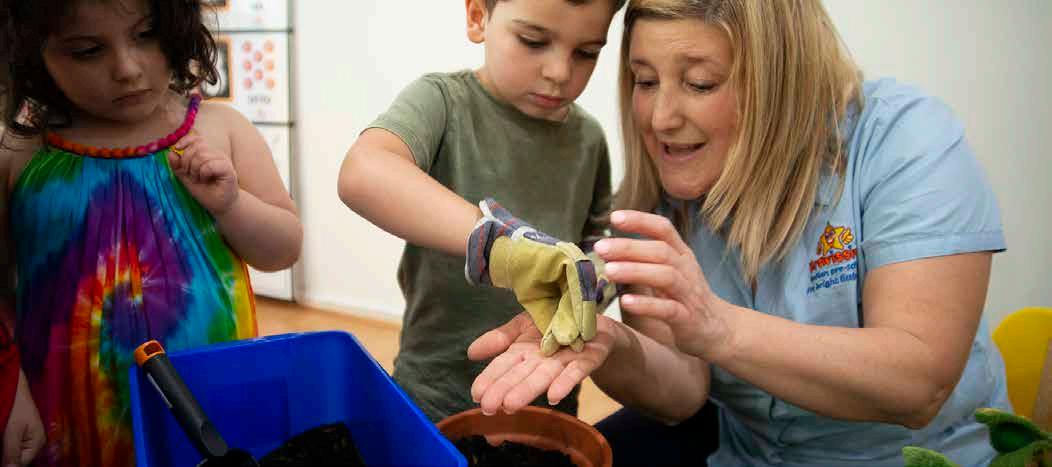
The emergence of Italian folk in Australia
The Fairbridge Festival, held in May this year, took on a special Italian theme. Folk legend Riccardo Tesi and the superb Banditaliana enchanted audiences with their contemporary, virtuosic take on music from the oral tradition in central and northern Italy. In another marquee, Aria winner Kavisha Mazzella and her band played a musical accompaniment to a rare and precious silent film, ‘Dall’Italia all’ Australia’ by Angelo Drovetti. Originally played in cinemas in Italy in 1925, the film, showing footage from the ship, was an hourlong advertisement for migration to Australia, promising an adventure and an exciting new life.
Melbourne-based Italian folk band Santa Taranta also presented their new show, ‘Songs from the Homeland’, folk songs collected for the National Library of Australia, and a tribute to the music of Italian migrants throughout the country.
Through this careful artistic direction, Rod Vervest,
director of Fairbridge Festival, created a snapshot of Italian
folk culture in Australia as it is at this unique moment
in history. The experience of the post-war migrants is
honoured by Kavisha, the daughter of this generation. The
music of these migrants is reimagined by Santa Taranta,
and Italian culture in Australia is valued, given a place at one
of Australia’s most prominent and well-loved folk festivals,
alongside the crème de la crème of Italian folk musicians
(Riccardo Tesi and Banditaliana).
Last year, the Italian nu-folk scene was surely stimulated by
visiting Sicilian power trio Oi Dipnoi, as well as Unavantaluna,
also from Sicily. Their concerts in Melbourne and Sydney
showed that Australian audiences are more than ready to
embrace authentic, contemporary Italian folk.
Following on from this enthusiasm, in March this year, Melbourne saw the debut of the Taranta Festival, an exciting new cultural initiative. The aim of this festival is to highlight Italian folk genres as an exciting global trend. Who better to launch this idea than Canzoniere Grecanico Salentino (CGS), which was formed in the 1970’s and, now in its second generation, has exploded onto the global world music scene, winning Best Band at the 2019 SONGLINES awards.
At the Taranta Festival’s opening concert at the Thornbury Theatre, CGS was supported by Dora and Angelo Marchese. Now in their 80s, this duo have been performing in Melbourne for decades, and represent the beginnings of Italian live music in Australia. Folk and Romany group Vardos Trio, also played at this event, their invigorating set sandwiched between Dora and Angelo Marchese and CGS. Vardos, in this context, represent the interaction between cultures that enriches the Australian music scene, providing a vital context to the way Italian musical culture has evolved in Australia, that is, not in a vacuum, but as part of a constant cultural dialogue.
Meanwhile, in Griffith NSW, a group of young people,
including organiser Patrick Zurilli, were bringing to life the
first edition of The Griffith Italian Festival, which sold out in
the days preceding the event.
With 60% of our population coming from Italian
background, we asked ourselves why there wasn’t already an
Italian festival in Griffith’, Patrick says. The organisers took
inspiration from one of Australia’s biggest Italian festivals,
the Melbourne Italian Festa in Lygon St, Carlton.
Fairbridge Festival closing parade
‘We went down to Melbourne, and we saw what they were doing there. We had some bands from Melbourne, but what differentiates us is that we were really wanting to showcase our local Italian culture.’
The future, Patrick says, is about reconnection.
‘We want to focus on the local, but in future we would be really open to working with people from Italy and learning from them. Especially for us younger generations, that would be a good way to learn about our roots, to reconnect.’
The Griffith Italian Festival lineup included nu-folk groups like The Rustica Project, whose members include a mix of first and second-generation Italian migrants.
In this way, the festival is already opening these channels of communication between the old and the new. Also of note at Griffith was Siesta Cartel, a charming new group that describes themselves as ‘young Italians from Melbourne,’ declaring proudly the existence of Italian culture and identity beyond the Italian peninsula.
Photo David LeMay

Siesta Cartel play Italian music learnt here from their
parents, Grandparents and their records. ‘The music that
raised them,’ as they describe it, is made new and fashionable
again as it is reimagined by them.
Italian folk bands included in the program of Australian
folk festivals, visiting artists from Italy collaborating with
Australian artists from Italian and other traditions, second
and third generation Italian-Australians re-interpreting the
music of their childhoods, new migrants connecting with
the musicians who have provided the soundtrack to country
halls and Italian clubs since the 50s and 60s.
All of these elements are currently present in the Australian music scene, and each of them are necessary to truly reflect the complexity of Italian music culture in Australia. With so many new initiatives, and new ways of including Italian music in existing events and festivals, it’s an exciting time for Italian music and entertainment in Australia.

Raise bilingual kids! Give them a skill they will cherish for life
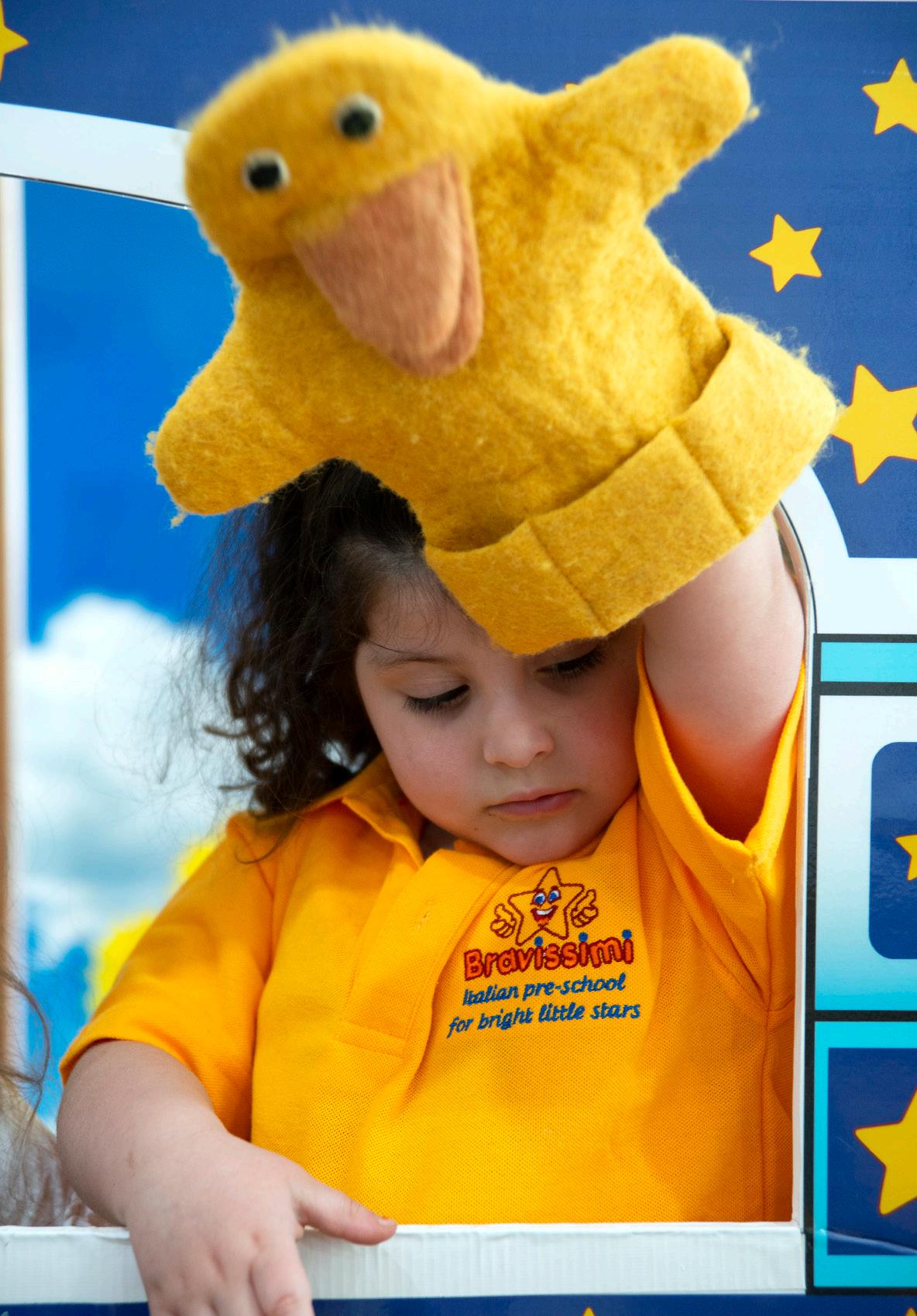
Giusi Galbo, Founder and Teacher at Bravissimi School

OPENING SOON NEW BRANCH AT BRUNSWICK SOUTH PRIMARY SCHOOL

Airport West and Princes Hill - Enquiries 03 9338 0831 - www.bravissimi.com.au
Let them embrace the benefits of a bilingual education

the first school in Victoria to offer a bilingual education IN ITALIAN
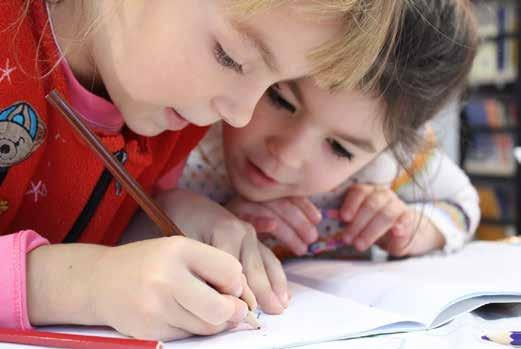

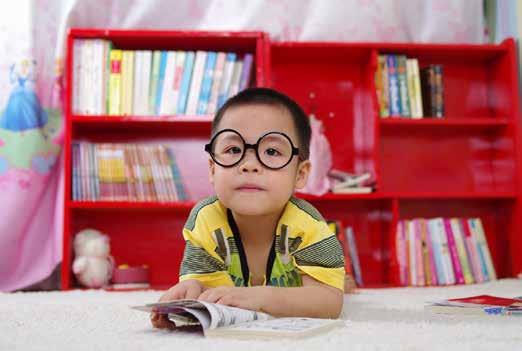

56 Brunswick Road Brunswick East VIC 3057 ph. 03 9380 1231 brunswick.south.ps@edumail.vic.gov.au brunswicksouthps.vic.edu.au

Committed as we are to fueling the controversy over the Italian ‘decline’ (as defined by the Italian economic newspaper Il Sole 24 Ore), we often forget about the reputation that the Italian system has earned and maintained in various sectors for several decades.
Daniele Curto
AN ACHIEVEMENT TO REFLECT ON
Despite many problems, it is known that Italy is the second industrial power in Europe (second only to the ‘locomotive’ Germany).
There are also achievements that are unexpected, for example, that Italy ranks as the first agricultural power in the EU, or that the Italian share in the export of textile machines and shoe machines is among the most significant in the world. Also surprising is that Italy is among the leaders at a global level in the circular economy for waste recovery, with 307 tons of material per million euro produced.
According to data from the World Trade Organization, there are at least eight sectors in which Italy excels, from mechanics to agriculture, to food, to fashion… to name just a few.
But there is a field in which Italy is the undisputed world leader, and that is culture. This was recently stated by the 2019 Best Countries report, by the U.S. News and World Report, in collaboration with BAV Group and University of Pennsylvania, which assigns Italy the gold medal for the most relevant cultural influence on an international scale. This is the recognition that perhaps should surprise us the least, given that ours (together with China) is the country in the world with the highest number of UNESCO sites (55) and holds 60% of global artistic and cultural heritage.
This special 20th edition of Segmento comes from a reflection on this wonderful honour.
The first publication of Segmento saw the light of day five years ago, pursuing the goal of providing young generations with a narrative of Italy that reflects the broad spectrum of its cultural offerings in today’s world.
Italian culture is a living body and like all living organisms, it undergoes crucial changes for its own survival. If we paraphrase the Latin poet, Ovid, we could argue that culture changes and renews itself, avoiding the danger that it suffocates in asphyxiated clichés and perishes.
Guided by this belief, Segmento’seditorial team asked itself a seriesof questions: what is the degree androle that Italian culture plays in theItalian community (and not only)in young people, starting with theyoungest children? What is the rolethat Italian institutions, private bodiesand Australian organisations play inspreading and teaching Italian culture?What kind of future are we forging forour culture, and what idea of Italy arewe transmitting to our children andgrandchildren?
I take great pleasure in thankingall those who, together with us, havetried to answer these complex andstimulating questions to contribute to adebate, of which the outcome will shapethe young Italian families of tomorrowin Australia and the sense of a culturalidentity capable of influencing not onlythe Australian community, but a large
part of the human consortium.
Thank you for the constantsupport offered to Segmento and thecontribution of ideas for this edition inparticular to:
• The Italian Consulate, Melbourne
• The Italian Cultural Institute,Melbourne
• The Elderly Assistance Committee(Co.As.It.), Melbourne
• Deakin University
• Monash University

• Bravissimi School, Melbourne
• Brunswick South Primary School,Melbourne

UNAPOLOGETICALLY ITALIAN

